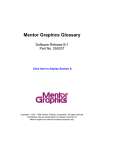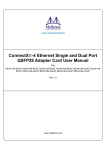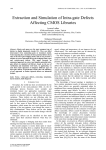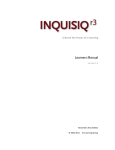Download PDF ERC Pathchk
Transcript
ERC Pathchk
Specification statement
Reports nets in the layout that do or do not have a path to power, ground or
labeled nets, or that satisfy a combination of these conditions. Used during circuit
extraction in Calibre nmLVS, Calibre nmLVS-H, and ICtrace Mask mode.
Note
This statement is provided primarily for backward compatibility. The Pathchk layer stat
conducting ERC checks.
Usage
ERC PATHCHK
{labeled_flag | power_ground_flag [operand power_ground_flag]}
[POLYGONS NETS | POLYGONS | NETS]
[BY LAYER] [BY CELL | FLAT]
[PORTS ALSO] [NOFLOAT] [EXCLUDE UNUSED]
[EXCLUDE SUPPLY]
Parameters
labeled_flag
A required string that specifies how the tool reports a net that does or does not
have a path to a top-level labeled net. This option requires top-level connectivity
(Text Layer) text objects that are neither power nor ground net labels to be
present. Possible choices are:
•
LABELED — Reports nets with a path to a labeled (Text Layer) net.
! LABELED — Reports nets with no path to any labeled (Text Layer) net.
where the exclamation mark (!) is synonymous with Boolean NOT.
A labeled_flag may not be specified with a power_ground_flag.
power_ground_flag
A required string that specifies how the tool reports a net that does or does not
have a path to a top-level supply net. Power and ground nets are top-level nets
specified in the LVS Power Name and LVS Ground Name statement. This option
requires top-level connectivity (Text Layer) text objects that are power and/or
ground net labels to be present. Possible choices are:
•
POWER — Reports nets with a path to a power net.
! POWER — Reports nets with no path to a power net.
GROUND — Reports nets with a path to a ground net.
! GROUND — Reports nets with no path to a ground net.
Where the exclamation mark (!) is synonymous with Boolean NOT.
The labeled_flag and the power_ground_flag keywords, when not connected by
an operand, are called primitive conditions.
operand
An optional string of logical symbols that combine two primitive conditions. Possible
choices are:
•
&& — Selects nets that satisfy both primitive conditions: Boolean AND.
|| — Select nets that satisfy the first or second primitive condition, or both:
Boolean OR.
POLYGONS NETS | POLYGONS | NETS
Specifies the type of results file to output. Possible choices are:
•
POLYGONS — Generates an Calibre nmDRC results database in ASCII format that
contains the polygon output of all nets that satisfy the specified conditions.
NETS — Generates a text file that contains a list of all nets that satisfy the specified
conditions.
Both are specified by default.
BY LAYER [BY CELL | FLAT]
An optional keyword set that specifies the type of output to include in the
generated ASCII results file. These pertain to the POLYGONS option only. Possible
choices are:
•
BY LAYER — Generates a separate check for each layer. If both BY CELL and BY
LAYER are specified, a check is generated for each layer in each cell. Empty checks
are not generated.
BY CELL — Causes each cell that has cell-specific results to be checked separately.
The check contains nets reported in that cell. The results are reported in top-level
coordinate space. BY CELL is ignored in flat execution.
FLAT — Causes cell-specific results to be replicated in every placement. FLAT has
no effect in flat execution.
PORTS ALSO
An optional keyword that specifies to output polygons on nets that are connected
only to port objects (nets having Text Layer objects on them are not included). By
default, such nets are not included in the output for any request. The PORTS ALSO
option removes the special treatment of port nets. This option affects both
POLYGONS and NETS output. Note that port objects are specified with the Port
Layer Text in Calibre, and the $make_port() command in Pyxis Layout.
•
NOFLOAT
An optional keyword that instructs the statement to ignore floating nets. Floating
nets are nets that are not connected to any devices.
•
EXCLUDE UNUSED
An optional keyword that instructs the statement to exclude unused nets from the
ERC Pathchk output. Unused nets are connected only to unused devices. Unused
devices are specified with LVS Filter Unused Option or equivalent LVS Filter Unused
•
statements. All options for LVS Filter Unused Option are supported except the INV,
P, and Q options.
EXCLUDE SUPPLY
An optional keyword that instructs the tool to exclude power and ground nets from
the results of an ERC Pathchk request containing at least one of the
keywords POWER or GROUND (not preceded by the ! operator). Supply nets are
included if EXCLUDE SUPPLY is not specified.
•
Description
Reports nets in the layout that do, or do not, have a path to top-level power and/or
ground nets, or labeled nets.
By default, a path is any route that leads through source/drain pins of built-in MOS
devices or pos/neg pins of built-in resistor devices. To qualify, a MOS device (types
M, ME, MD, MN, MP, or any of the LDD-type devices) must have at least the
following pins: G (or gate), S (or source), and D (or drain). Paths through LDD-type
devices are formed in both directions. Capacitor, diode, or bipolar devices can also
be added to the path, as specified in ERC Path Also statements.
If you want to enable user-defined devices to participate in ERC Pathchk (userdefined devices do not participate by default), then you must map these devices
and their pins to built-in devices and pins. This is done using the LVS Device
Type specification statement. See “User-Defined Devices in Path Check Operations”
in the Calibre Verification User’s Manual.
Power and ground nets are specified with LVS Power Name and LVS Ground
Name specification statements, respectively. This statement utilizes wildcard
characters that appear in LVS Power Name and LVS Ground Name specification
statements. Power and ground nets break paths.
The hierarchical level from which text objects are read is controlled by the Text
Depth statement.
Power and ground nets are included in the result for the
keywords POWER and GROUND. For example, supply nets are included if you
specify:
ERC PATHCHK POWER
You can exclude supply nets by specifying EXCLUDE SUPPLY. When specifying
EXCLUDE SUPPLY, at least one of the POWER or GROUND keywords must also be
specified in the statement. (The EXCLUDE SUPPLY keyword does not apply to
the ! POWER or ! GROUND keywords.) For example:
ERC PATHCHK POWER && ! GROUND EXCLUDE SUPPLY
is allowed. However, this form causes a compiler error:
ERC PATHCHK ! POWER && ! GROUND EXCLUDE SUPPLY // bad
syntax
Power and ground nets are not included in the result for ! POWER and !
GROUND keywords. The supply net itself is not selected even if there is no path
from power to ground. For example:
ERC PATHCHK ! GROUND
If a net in the design matches more than one of LVS Power Name or LVS Ground
Name name patterns, a warning is issued and conflicts are resolved with power
names being given priority over ground names.
The LABELED nets are those with connectivity extraction (Text Layer) text, but
they are not power or ground nets.
By default, nets that are labeled by port objects alone (no Text Layer objects) are
not output. The PORTS ALSO option changes this behavior. All objects from nets
connected to top-level nets named by port objects alone are output.
ERC Pathchk statements respect the LVS Compare Case statement. If either the
LVS Compare Case YES or LVS Compare Case NAMES statement is specified, then
power names and ground names are traced in a case-sensitive manner; otherwise
they are case insensitive. These rules on case sensitivity apply to LVS Power Name
and LVS Ground Name nets.
ERC Pathchk observes the Layout Preserve Case specification statement for casesensitivity of net names. See “Case Sensitivity of Supply Net Names” in the Calibre
Verification User’s Manual for more details.
This statement applies to Calibre nmLVS/Calibre nmLVS-H and ICtrace Mask mode.
It is executed during circuit extraction and only when the layout is geometric. The
following Calibre commands execute this statement:
calibre -lvs rules
calibre -lvs -tl ... rules
calibre -lvs -hier ... rules
//
//
//
//
executed flat
executed flat
executed hierarchically with
geometric Layout System
calibre -spice ... rules
The following Pyxis Layout commands execute this statement:
$lvs_mask()
$write_mask_cnet()
// executed flat
// executed flat
Note the following important considerations:
•
The POWER, GROUND, and LABELED options (without the ! operator) are
not recommended because they can generate very large files, consume large
amounts of memory, and lead to long runtimes. In particular, in hierarchical
ERC, such requests essentially flatten the design hierarchy.
•
In the default mode, with neither FLAT nor BY CELL specified, the polygon
output may contain polygons belonging to a cell in two ways:
o
If a net in the cell violates ERC Pathchk requirements in some placements
of this cell, the polygons are written out for each placement where the
violation occurs in top-level coordinates.
o
If, for a given net, a violation appears in every placement of a cell, the
polygons are written out once, in the lowest, leftmost placement.
This can lead to confusion because, in the same cell, some polygons may be
displayed in many placements and others in only one placement. If the results are
difficult to interpret, the BY CELL option can be useful.
The FLAT option can also be used to force Calibre to output cell-specific results in all
placements. This increases both memory consumption and the size of the polygon
file, but can eliminate potential confusion caused by hierarchical output. However,
output using the NETS option is unambiguous in all cases.
ERC Pathchk statements are not executed if the specified net is not present. For
example, if there is no power net in the layout, then ERC PATHCHK ! POWER
generates an error message and generates no output.
Results Output Options
The output files are readable by RVE similar to a DRC Results Database.
POLYGONS — The POLYGONS option specifies a file
named layout_primary.pathchk.erc. It is placed in the Mask SVDB Directory if that
statement is specified, otherwise in the current working directory.
If layout_primary is not specified, the word lvs is used instead. The file consists of
lines in the format:
ERC PATHCHK condition [ in cell cell_name ] [ layer_name ]
where condition is the specified condition, such as ! POWER or ! POWER &&
GROUND. By default, results from each ERC Pathchk statement are written to one
check in the result file. If the BY CELL option is specified, then the results are
classified by cell and the cell_name field indicates the cell name. If the BY LAYER
option is specified, then the results are classified by layer and the layer_name field
indicates the layer. Empty checks are not written. If all checks are empty, no file is
created.
All polygon results are shown in the top-level coordinate space, and they are
written to a Calibre nmDRC results database in ASCII format. By default,
hierarchical Calibre shows cell-specific results only once in a representative
placement of the cell. The lowest, leftmost placement of each cell serves as its
representative. This is similar to Calibre nmDRC-H. Results are cell-specific if they
can be generated locally in the cell and occur in all placements of the cell in the
design.
Note that polygon results generated by ERC Pathchk are not fully merged. This
means that polygons can abut or overlap.
NETS — The NETS option specifies a file named layout_primary.pathchk.rep. It is
placed in the SVDB directory by default, otherwise in the current working directory.
Iflayout_primary is not specified, the word lvs is used instead.
In hierarchical execution, the report file format is this:
ERC PATHCHK REPORT for layout_primary
ERC PATHCHK condition:
cell cell_name (placement): net1, net2, ...
cell cell_name (placement): net1, net2, ...
where condition is the specified condition, such as GROUND AND !
POWER, cell_name is a cell name where results were found, placement is a
representative placement of that cell, and neti is a net name or number. Cells are
listed in bottom-up order. Net names and numbers are in the context of the
indicated cells. Cells for which no nets are found by ERC Pathchk are not written to
the report file.
In flat execution, the report file format is:
ERC PATHCHK REPORT for layout_primary
ERC PATHCHK condition:
net1, net2, ...
Nothing is reported for requests in which no nets are found in any cell. If all checks
are empty, no file is created.
Requirements and Restrictions
Hierarchical Calibre operations impose a size limit on intermediate data structures
generated by ERC Pathchk. The limit is approximately 400 MB. This limit is applied
independently to each individual ERC Pathchk statement. Calibre generates
incomplete results (some polygons may be omitted from the output) and issues the
following warning if Calibre reaches this limit:
WARNING: ERC operation exhausted allowed memory allocation.
Calibre issues the warning in both the transcript and the circuit extraction report.
This limit applies only to polygon output, for example during the construction of a
result layer and when performing the POLYGONS option.
Calibre always completes the net reporting part of this functionality, including the
functionality resulting from the NETS option.
You should not reach this limit in normal operations. You see it only in
circumstances when a very large net is selected by the ERC Pathchk statement.
See also ERC Summary Report. The search features Find Path and Isolate Path on
Layout Net in Calibre RVE for LVS may also be of interest.
Examples
Example 1
The following statement outputs a text file listing all the nets with a path to a
labeled net:
ERC PATHCHK LABELED NETS
Example 2
When not using the [ ! ] LABELED option, the following combinations are possible:
! POWER && GROUND
Nets with no path to power but with a path to ground
! GROUND && POWER
Nets with no path to ground but with a path to power
! GROUND && ! POWER
Nets with no path to ground and no path to power
! GROUND || ! POWER
Nets with no path to ground or no path to power (or both)
POWER && GROUND
Nets with a path to both power and ground
POWER || GROUND
Nets with path to power or a path to ground













